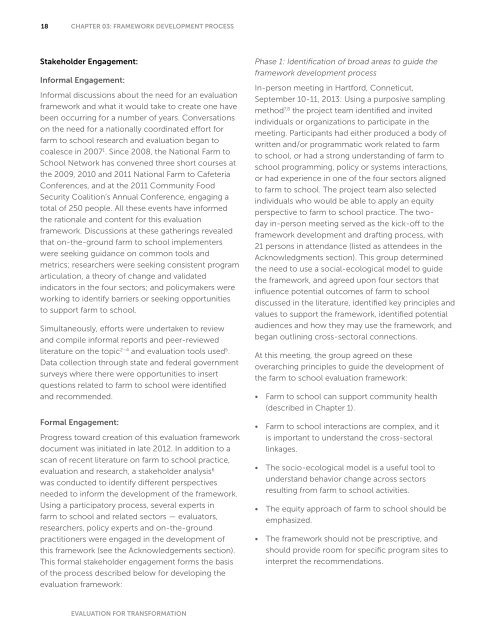Framework-08-25-14_web
Framework-08-25-14_web
Framework-08-25-14_web
Create successful ePaper yourself
Turn your PDF publications into a flip-book with our unique Google optimized e-Paper software.
18 CHAPTER 03: FRAMEWORK DEVELOPMENT PROCESSStakeholder Engagement:Informal Engagement:Informal discussions about the need for an evaluationframework and what it would take to create one havebeen occurring for a number of years. Conversationson the need for a nationally coordinated effort forfarm to school research and evaluation began tocoalesce in 2007 1 . Since 20<strong>08</strong>, the National Farm toSchool Network has convened three short courses atthe 2009, 2010 and 2011 National Farm to CafeteriaConferences, and at the 2011 Community FoodSecurity Coalition’s Annual Conference, engaging atotal of <strong>25</strong>0 people. All these events have informedthe rationale and content for this evaluationframework. Discussions at these gatherings revealedthat on-the-ground farm to school implementerswere seeking guidance on common tools andmetrics; researchers were seeking consistent programarticulation, a theory of change and validatedindicators in the four sectors; and policymakers wereworking to identify barriers or seeking opportunitiesto support farm to school.Simultaneously, efforts were undertaken to reviewand compile informal reports and peer-reviewedliterature on the topic 2–4 and evaluation tools used 5 .Data collection through state and federal governmentsurveys where there were opportunities to insertquestions related to farm to school were identifiedand recommended.Formal Engagement:Progress toward creation of this evaluation frameworkdocument was initiated in late 2012. In addition to ascan of recent literature on farm to school practice,evaluation and research, a stakeholder analysis 6was conducted to identify different perspectivesneeded to inform the development of the framework.Using a participatory process, several experts infarm to school and related sectors — evaluators,researchers, policy experts and on-the-groundpractitioners were engaged in the development ofthis framework (see the Acknowledgements section).This formal stakeholder engagement forms the basisof the process described below for developing theevaluation framework:Phase 1: Identification of broad areas to guide theframework development processIn-person meeting in Hartford, Conneticut,September 10-11, 2013: Using a purposive samplingmethod 7,8 the project team identified and invitedindividuals or organizations to participate in themeeting. Participants had either produced a body ofwritten and/or programmatic work related to farmto school, or had a strong understanding of farm toschool programming, policy or systems interactions,or had experience in one of the four sectors alignedto farm to school. The project team also selectedindividuals who would be able to apply an equityperspective to farm to school practice. The twodayin-person meeting served as the kick-off to theframework development and drafting process, with21 persons in attendance (listed as attendees in theAcknowledgments section). This group determinedthe need to use a social-ecological model to guidethe framework, and agreed upon four sectors thatinfluence potential outcomes of farm to schooldiscussed in the literature, identified key principles andvalues to support the framework, identified potentialaudiences and how they may use the framework, andbegan outlining cross-sectoral connections.At this meeting, the group agreed on theseoverarching principles to guide the development ofthe farm to school evaluation framework:• Farm to school can support community health(described in Chapter 1).• Farm to school interactions are complex, and itis important to understand the cross-sectorallinkages.• The socio-ecological model is a useful tool tounderstand behavior change across sectorsresulting from farm to school activities.• The equity approach of farm to school should beemphasized.• The framework should not be prescriptive, andshould provide room for specific program sites tointerpret the recommendations.EVALUATION FOR TRANSFORMATION


